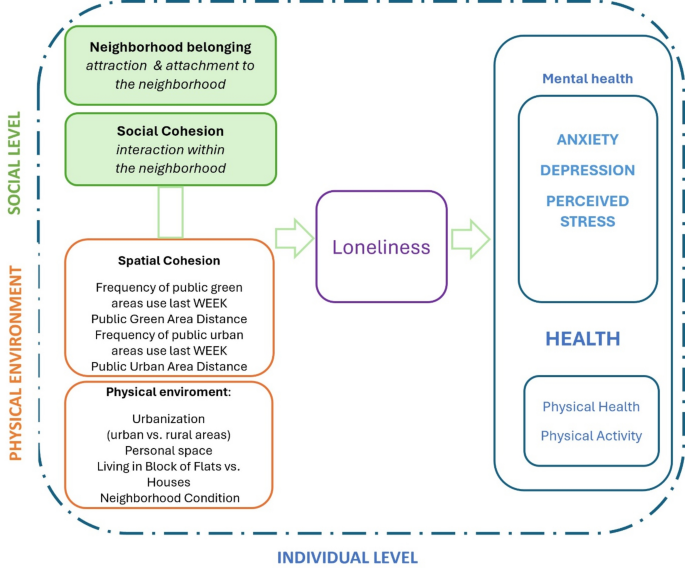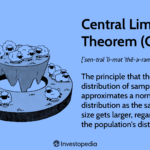Adli, M. et al. Neurourbanism—a joint methodological approach between urban planning and neurosciences. Die Psychiatrie 13, 70–78 (2016).
UNDP. Human Development Report 2021–22: Uncertain Times, Unsettled Lives: Shaping our Future in a Transforming World (PDF). hdr.undp.org. United Nations Development Programme, 272–276 (2022). ISBN 978–9–211–26451–7.
van der Wal J.M., et al. Advancing urban mental health research: from complexity science to actionable targets for intervention. Lancet Psychiatry. 8, 991–1000; (2021).
Peen, J., et al. The current status of urban-rural differences in psychiatric disorders. Acta Psychiatr Scand. 121, 84–93; (2010).
Baxter, A.J. et al. Global prevalence of anxiety disorders: a systematic review and meta-regression. Psychol Med. 43, 897–910; (2013).
Jacobi, F. et al. Twelve-month prevalence, comorbidity and correlates of mental disorders in Germany: the Mental Health Module of the German Health Interview and Examination Survey for Adults (DEGS1-MH). Int J Methods Psychiatr Res. 23, 304–319 (2014).
Generaal, E., et al. Not urbanization level but socioeconomic, physical and social neighborhood characteristics are associated with presence and severity of depressive and anxiety disorders. Psychol Med. 49, 149–161; (2019).
Lim, G.Y., et al. Prevalence of Depression in the Community from 30 Countries between 1994 and 2014. Sci Rep 8, 2861; (2018).
de Vries, S., et al. Local availability of green and blue space and prevalence of common mental disorders in the Netherlands. British Journal of Psychiatry Open 2, 366–372; (2016).
Rapp, M. A. et al. When local poverty is more important than your income: Mental health in minorities in inner cities. World Psychiatry 14, 249–250 (2015).
Honold, J., Wippert, P. M. & van der Meer, E. Urban health resources: physical and social constitutes of neighborhood social capital. Procedia Soc Behav Sci 131, 491–496 (2014).
Meyer, O. L., Castro-Schilo, L. & Aguilar-Gaxiola, S. Determinants of mental health and self-rated health: a model of socioeconomic status, neighborhood safety, and physical activity. Am J Public Health 104, 1734–1741 (2014).
Fone, D. et al. Effect of neighborhood deprivation and social cohesion on mental health inequality: a multilevel population-based longitudinal study. Psychol Med 44, 2449–2460 (2014).
Maimon, D., Browning, C. R. & Brooks-Gunn, J. Collective efficacy, family attachment, and urban adolescent suicide attempts. J Health Soc Behav 51, 307–324 (2010).
Galea, S. et al. Urban neighborhood poverty and the incidence of depression in a population-based cohort study. Ann Epidemiol 17, 171–179 (2007).
Veling, W. et al. Ethnic density of neighborhoods and incidence of psychotic disorders among immigrants. Am J Psychiatry 165, 66–73 (2008).
Norman, P., Boyle, P. & Rees, P. Selective migration, health and deprivation: a longitudinal analysis. Soc Sci Med 60, 2755–2757 (2005).
Ahern, J. & Galea, S. Collective efficacy and major depression in urban neighborhoods. Am J Epidemiol 173, 1453–1462 (2011).
Bertotti, M. et al. Types of social capital and mental disorder in deprived urban areas: a multilevel study of 40 disadvantaged London neighborhoods. PLoS ONE 8, e80127 (2013).
Fonseca, X., Lukosch, S., Brazier, F. Social cohesion revisited: a new definition and how to characterize it. Innovation: Eur J Soc Sci 32, 231–253 (2019).
Ludin, S.M., Rohaizat, M., Arbon, P. The association between social cohesion and community disaster resilience: A cross-sectional study. Health Soc Care Community. 27, 621–631; (2019).
Miller, H.N., et al. Social Cohesion in Health: A Concept Analysis. ANS Adv Nurs Sci. 43, 375–390; (2020).
Williams, A.J., et al. Social cohesion, mental wellbeing and health-related quality of life among a cohort of social housing residents in Cornwall: a cross sectional study. BMC Public Health. 20, 985; (2020).
Feng, Z., Vlachantoni, A., Liu, X., Jones, K. Social trust, interpersonal trust and self-rated health in China: a multi-level study. Int J Equity Health 15, 180; (2016).
Chuang, Y.C., Chuang, K.Y., Yang, T.H. Social cohesion matters in health. Int J Equity Health 12, 87; (2013).
Buckner, J. C. The development of an instrument to measure neighborhood cohesion. Am J Commun Psychol 16, 771–791. (1988).
Breedvelt, J. J. F. et al. The effects of neighbourhood social cohesion on preventing depression and anxiety among adolescents and young adults: rapid review. BJPsych Open. 8, e97 (2022).
Grahn, P. & Stigsdotter, U. A. Landscape planning and stress. Urban forestry & urban greening 2, 1–18 (2003).
Hadavi, S., Kaplan, R. & Hunter, M. R. How does perception of nearby nature affect multiple aspects of neighborhood satisfaction and use patterns?. Landsc. Res. 43, 360–379 (2018).
Shackleton, C. M. & Blair, A. Perceptions and use of public green space is influenced by its relative abundance in two small towns in South Africa. Landsc. Urban Plann. 113, 104–112 (2013).
Wendel, H. E. W., Zarger, R. K. & Mihelcic, J. R. Accessibility and usability: green space preferences, perceptions, and barriers in a rapidly urbanizing city in Latin America. Landsc. Urban Plann. 107, 272–282 (2012).
Macintyre, S., Macdonald, L. & Ellaway, A. Lack of agreement between measured and self-reported distance from public green parks in Glasgow. Scotland. Int. J. Behav. Nutr. Phys. Activ. 5, 1–8 (2008).
Sugiyama, T., Leslie, E., Giles-Corti, B. & Owen, N. Associations of neighborhood greenness with physical and mental health: do walking, social coherence and local social interaction explain the relationships?. J. Epidemiol. Community 62, e9–e9 (2008).
Rogowska, A.M., et al. Does Physical Activity Matter for the Mental Health of University Students during the COVID-19 Pandemic? J Clin Med. 9, 3494; (2020).
Gruebner, O., et al. Urban health in megacities: extending the framework for developing countries. Bonn: International Human Dimensions Programme (IHDP) (2011).
Rocha, K. et al. Perception of environmental problems and common mental disorders (CMD). Soc Psychiatry Psychiatr Epidemiol 47, 1675–1684 (2012).
Honold, J., Beyer, R., Lakes, T. & van der Meer, E. Multiple environmental burdens and neighborhood-related health of city residents. J Environ Psychol 32, 305–317 (2012).
Asgarzadeh, M. et al. Investigating green urbanism. Building Oppressiveness 9, 555–562 (2010).
Asgarzadeh, M., Lusk, A., Koga, T. & Hirate, K. Measuring oppressiveness of streetscapes. Landsc Urban Plan 107, 1–11 (2012).
Guite, H. F., Clark, C. & Ackrill, G. The impact of the physical and urban environment on mental well-being. Public Health 120, 1117–1126 (2006).
Sampson, R. J. & Raudenbush, S. W. Seeing disorder: Neighborhood stigma and the social construction of “broken windows”. Soc Psychol Q 67, 319–342 (2004).
Hammersen, F., Niemann, H. & Hoebel, J. Environmental noise annoyance and mental health in adults: findings from the Cross-Sectional German Health Update (GEDA) Study 2012. Int J Environ Res Public Health 13, 954 (2016).
evidence from Iran. Azadeh, S.R., Mohammadi, J., Neshat Doost, H.T. The relationship between urban environmental quality and mental health (depression scale). J Urban Environ Eng 13, 285–293 (2019).
Houlden, V., Weich, S. & Jarvis, S. A cross-sectional analysis of green space prevalence and mental wellbeing in England. BMC Publ Health 17, 1–9 (2017).
Riyahi, M. A., Verdiniya, A. & Pourhossein, Z. Studying the relationship between social support and mental health. J. Soc. Welfare 10, 85–121 (2010).
Zhang, T., Chiu, R. L. H. & Ho, H. C. Suburban neighborhood environments and depression: a case study of Guangzhou. China. J Transport Health 15, 100624 (2019).
Duncan, D. T. et al. The built environment and depressive symptoms among urban youth: a spatial regression study. Spat Spatiotemporal Epidemiol 5, 11–25 (2013).
Croucher, K., Myers, L., Bretherton, J. The Links between Greenspace and Health: a Critical Literature Review (University of York, 2007).
Gong, Y., Palmer, S., Gallacher, J., Marsden, T. & Fone, D. A systematic review of the relationship between objective measurements of the urban environment and psychological distress. Environ Int. 96, 48–57 (2016).
Gascon, M. et al. Mental health benefits of long-term exposure to residential green and blue spaces: a systematic review. Int J Environ Res Publ Health 12, 4354–4379 (2015).
Qiu, Y., Liu, Y., Liu, Y. & Li, Z. Exploring the linkage between the neighborhood environment and mental health in Guangzhou, China. Int J Environ Res Publ Health 16, 3206 (2019).
Dunstan, F. et al. An observation tool to assist with the assessment of urban residential environments. J Environ Psychol. 25, 293–305 (2005).
Mücher, C. A., et al. Spatial cohesion–an indicator for regional assessment of biodiversity in sensor. SENSOR. (2009).
Russell, D.W., Peplau, L.A., Cutrona, C.E. The Revised UCLA Loneliness Scale: Concurrent and discriminant validity evidence. J. Pers Soc Psych. 39, 472–480; (1980).
Cacioppo, J.T., Cacioppo, S., Boomsma, D.I. Evolutionary mechanisms for loneliness. Cogn Emot 28, 3–21; (2014).
Rugel, E.J., Carpiano, R.M., Henderson, S.B., Brauer, M. Exposure to natural space, sense of community belonging, and adverse mental health outcomes across an urban region. Environ Res 171, 365–377; (2019).
Hammoud, R., Tognin, S., Bakolis, I. et al. Lonely in a crowd: investigating the association between overcrowding and loneliness using smartphone technologies. Sci Rep 11, 24134; (2021).
MacDonald, K. J., Willemsen, G., Boomsma, D. I. & Schermer, J. A. Predicting loneliness from where and what people do. Soc Sciences 9, 51 (2020).
Romans, S., Cohen, M., Forte, T. Rates of depression and anxiety in urban and rural Canada. Soc Psychiatry Psychiatr Epidemiol. 46, 567–75; (2011).
Layden, E.A., Cacioppo, J.T., Cacioppo, S. Loneliness predicts a preference for larger interpersonal distance within intimate space. PLoS One 13, e0203491; (2018).
Wells, N.M., Harris, J.D. Housing quality, psychological distress, and the mediating role of social withdrawal: A longitudinal study of low-income women. J. Environ.l Psych. 27, 69–78 (2007).
Chu, A., Thorne, A. & Guite, H. The impact on mental well-being of the urban and physical environment: an assessment of the evidence. J Pub Mental Health 3, 17–32 (2004).
Kearns, A., Whitley, E., Tannahill, C., Ellaway, A. Loneliness, social relations and health and well-being in deprived communities. Psychol Health Med 20, 332–344; (2015).
Liang, D., Teng, M., Xu, D. Impact of perceived social support on depression in Chinese rural-to-urban migrants: The mediating effects of loneliness and resilience. J Community Psychol. 47, 1603–1613; (2019).
van den Berg, M.M., et al. Do Physical Activity, Social Cohesion, and Loneliness Mediate the Association Between Time Spent Visiting Green Space and Mental Health? Environ Behav 51, 144–166; (2019).
Astell-Burt, T., Hartig, T., Putra, I.G.N.E., Walsan, R., Dendup, T., Feng, X. Green space and loneliness: A systematic review with theoretical and methodological guidance for future research. Sci Total Environ 847, 157521; (2022).
Astell-Burt,T., Hartig, T., Eckermann, S., et al. More green, less lonely? A longitudinal cohort study. Int J Epidemiol 51, 99–110; (2022).
Cacioppo, J. T., Cacioppo, S. Loneliness in the modern age: An evolutionary theory of loneliness (ETL). In Advances in experimental social psychology , 127–197 (Academic Press, 2018).
Bower, M. et al. ‘Trapped’, ‘anxious’ and ‘traumatized’: COVID-19 intensified the impact of housing inequality on Australians’ mental health. Int J Housing Policy 23, 260–291 (2023).
Sánchez-Moreno, E., Gallardo-Peralta, L.P., Leyton, C. The Social Gradient in Mental Health and Well-Being for Indigenous Older Adults Living in Rural Areas: A Cross-Sectional Comparison With Rural Non-indigenous Population in Chile. J Aging Health. 33, 287–299; (2021).
Jeste, D.V., Lee, E.E. Loneliness Versus Wisdom Amid Two Concurrent Pandemics of Loneliness. Am J Geriatr Psychiatry. 28, 1245–1247; (2020).
United Nations (2017). Mental health and human rights Report of the United Nations High Commissioner for Human Rights. documents-dds-ny.un.org/ accessed on May 2nd, 2023.
DeSalvo, K. B. et al. Assessing measurement properties of two single-item general health measures. Qual. Life Res. 15, 191–201 (2006).
World Health Organization. (2020). WHO guidelines on physical activity and sedentary behaviour: at a glance. World Health Organization. iris.who.int/handle/10665/337001.
Kochman, M., Kielar, A., Kasprzak, M., Maruszczak, K., Kasperek, W. The Relationship between Self-Rated Health and Physical Fitness in Polish Youth. Healthcare 12, 24; (2024).
Beyer, A.K., Wolff, J.K., Warner, L.M., Schüz, B., Wurm, S. The role of physical activity in the relationship between self-perceptions of ageing and self-rated health in older adults. Psychol Health 30, 671–685 (2015).
Gan, D. R. Y., Wister, A. V. & Best, J. R. Environmental Influences on Life Satisfaction and Depressive Symptoms Among Older Adults With Multimorbidity: Path Analysis Through Loneliness in the Canadian Longitudinal Study on Aging. Gerontologist 62, 855–864. (2022).
Gwosdz, K., Sobala-Gwosdz, A., Czakon, P. Poziom i dynamika rozwoju gospodarczego na obszarze GZM z uwzględnieniem funkcji metropolitalnych. [The level and dynamics of economic development in the GZM area, taking into account metropolitan functions]. irmir.pl/wp-content/uploads/2022/06/Current-economic-development-in-the-GZ-Metropolitan-Area_Gwosdz_Sobala-Gwosdz_Czakon.pdf (2021).
Scharf, T., de Jong Gierveld, J. (2008). Loneliness in urban neighbourhoods: an Anglo-Dutch comparison. Eur J Ageing 5, 103; (2008).
Finlay, J.M., Kobayashi, L.C. Social isolation and loneliness in later life: A parallel convergent mixed-methods case study of older adults and their residential contexts in the Minneapolis metropolitan area, USA. Soc Sci Med 208, 25–33; (2018).
van den Berg, P., Kemperman, A., De Kleijn, B. & Borgers, A. Ageing and loneliness: The role of mobility and the built environment. Travel Behaviour and Society 5, 48–55 (2016).
Avery, E.E., Hermsen, J.M., Kuhl, D.C. Toward a Better Understanding of Perceptions of Neighborhood Social Cohesion in Rural and Urban Places. Soc Indic Res 157, 523–541; (2021).
Robinette, J. W., Charles, S. T., Mogle, J. A., Almeida, D. M. Neighborhood cohesion and daily well-being: Results from a diary study. Soc Sc Med 96, 174–182; (2013).
Wan, C., Shen, G. Q. & Choi, S. Underlying relationships between public urban green spaces and social cohesion: A systematic literature review. City, Culture Soc 24, 100383 (2021).
De Risio, L. et al Staying connected: An umbrella review of meta-analyses on the push-and-pull of social connection in depression J Affect Disord 345, 358–368; (2024).
Rodríguez-Rey, R., Garrido-Hernansaiz, H., Collado, S. Psychological impact of COVID-19 in Spain: Early data report. Psychol Trauma. 12, 550–552; (2020).
Resnick, B., et al. Gender Differences in Function, Physical Activity, Falls, Medication Use, and Life Satisfaction Among Residents in Assisted Living Settings. Res Gerontol Nurs. 13, 31–40; (2020).
R Core Team. R: A Language and Environment for Statistical Computing. R Foundation for Statistical Computing, Vienna, Austria (2023).https://www.R-project.org/.
Epskamp, S., Cramer, A. O. J., Waldorp, L. J., Schmittmann, V. D. & Borsboom, D. qgraph: Network Visualizations of Relationships in Psychometric Data. J Stat Software 48, 1–18 (2012).
Haslbeck, J.M.B., Waldorp, L.J. mgm: Estimating Time-Varying Mixed Graphical Models in High-Dimensional Data. J Stat Software 93, 1–46; (2020).
Makowski, D., Lüdecke, D., Patil, I., Thériault, R., Ben-Shachar, M., Wiernik, B. Automated Results Reporting as a Practical Tool to Improve Reproducibility and Methodological Best Practices Adoption. CRAN easystats.github.io/report (2023).
Cohen, J.W. Statistical power analysis for the behavioral sciences (2nd edn) (Lawrence Erlbaum Associates, 1988).
Burger, J., et al. Reporting standards for psychological network analyses in cross-sectional data. Psychol Methods ; (2022).
Hallquist, M.N., Wright, A.G.C., Molenaar, P.C.M. Problems
Bringmann, L. F., et. al. What do centrality measures measure in psychological networks? J Abnormal Psych 128, 892–903; (2019).
Robinaugh, D. J., Millner, A. J. & McNally, R. J. Identifying highly influential nodes in the complicated grief network. J Abnorm Psychol 125(6), 747–757. (2016).
Spiller, T. R. et al. On the validity of the centrality hypothesis in cross-sectional between-subject networks of psychopathology. BMC Med. 18(1), 297. (2020).
Opsahl, T., Agneessens, F., Skvoretz, J. Node centrality in weighted networks: generalizing degree and shortest paths. Soc Networks. 32, 245–251; (2010).
Barber, R. F. & Drton, M. High-dimensional Ising model selection with Bayesian information criteria. Electr J Statistics 9, 567–607 (2015).
Foygel, R., Drton, M. Extended Bayesian information criteria for Gaussian graphical models. In Advances in neural information processing systems (604–612) (2010).
Haslbeck, J. M. B. & Waldorp, L. J. mgm: Estimating time-varying Mixed Graphical Models in high-dimensional Data. J Stat Software 93, 1–46 (2020).
Fruchterman, T.M.J., Reingold, E.M. Graph Drawing by Force-Directed Placement. Software: Practice and Experience, 21, 1129–1164 (1991).
Chen, F.F. Sensitivity of Goodness of Fit Indexes to Lack of Measurement Invariance. Struct. Equ. Modeling: A Multidiscip. J. 14, 464–504; (2007).
Baumgartner, H., Steenkamp, J.-B. E. M. Response styles in marketing research: A cross-national investigation. J Marketing Res 38, 143–156; (2001).
Afthanorhan, A. et al. Gain more insight from common latent factor in structural equation modeling. Journal of Physics: Conference Series 1, 012030 (2021).
Lowry, P. B. & Gaskin, J. Partial least squares (PLS) structural equation modeling (SEM) for building and testing behavioral causal theory: When to choose it and how to use it. IEEE transactions on professional communication 57, 123–146 (2014).
Cohen, S., Kamarck, T., Mermelstein, R. A global measure of perceived stress. Journal of Health and Social Behavior 24, 385–396; (1983).
Spitzer, R. L., Kroenke, K., Williams, J. B. W. & Löwe, B. A. Brief Measure for Assessing Generalized Anxiety Disorder. Arch. Intern. Med. 166, 1092–1097 (2006).
Kroenke, K., Spitzer, R.L., Williams, J.B. The PHQ-9: validity of a brief depression severity measure. J Gen Intern Med. 16, 606–13; (2001).
Ochnik, D. Challenges of the Public Space and Social Cohesion of the Metropolis GZM in Poland – an Interdisciplinary Approach. OSF. osf.io/78cxs (2023).



